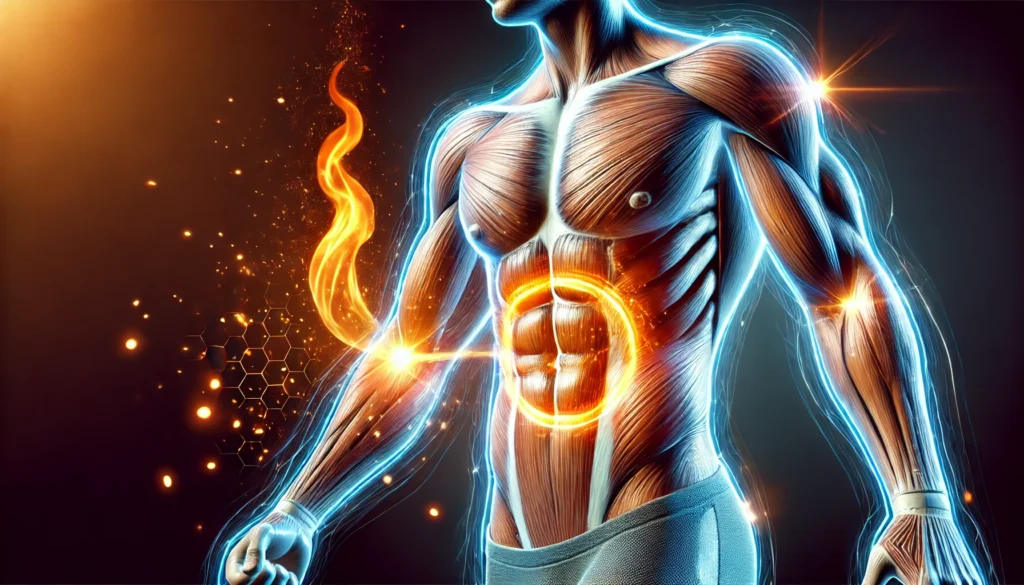Introduction: The Science of Fat Loss and Its Challenges
Losing body fat efficiently and sustainably remains one of the most common health and fitness goals. Many individuals seek the fastest way to burn fat, aiming for results that are both quick and long-lasting. However, navigating the vast sea of weight loss advice can be overwhelming. The effectiveness of any fat-burning strategy hinges on a combination of scientific principles, behavioral consistency, and personalized adjustments. Understanding how to burn body fat involves not just exercise and dieting but also a deep comprehension of metabolic processes, hormonal influences, and psychological factors that drive long-term success.
You may also like: The Ultimate Bodyweight Workout Routine for Full-Body Strength and Performance
In this comprehensive guide, we will explore expert-backed strategies that offer the fastest way to burn fat without compromising overall well-being. Whether you are looking for ways to burn fat fast, aiming to shed fat for a specific event, or seeking a sustainable plan for lifelong health, this article will provide evidence-based insights into maximizing fat loss. By following a structured yet adaptable approach, you can learn how to decrease body fat effectively while maintaining energy levels and preserving muscle mass.
Understanding How the Body Burns Fat
Fat loss occurs when the body taps into its stored energy reserves to meet its daily energy needs. The body primarily derives energy from carbohydrates and fats, switching between these two sources depending on factors like activity levels, diet composition, and metabolic rate. The process of fat oxidation, wherein stored fat is broken down into usable energy, is influenced by factors such as caloric intake, exercise intensity, and hormonal regulation.
When considering how to shed body fat, it is essential to grasp the concept of caloric balance. A calorie deficit—where energy expenditure exceeds energy intake—is the cornerstone of fat loss. However, this process is more nuanced than simply consuming fewer calories. The type of food consumed, meal timing, and macronutrient distribution all contribute to the efficiency of fat loss. Understanding the metabolic pathways that govern fat breakdown allows individuals to optimize their approach, ensuring both rapid and sustainable fat loss.
Optimizing Nutrition for Maximum Fat Loss
The Role of Macronutrients in Fat Loss
Nutrition plays a crucial role in determining how to burn fat quickly. Each macronutrient—proteins, carbohydrates, and fats—affects metabolism differently. Protein, for example, has a high thermic effect, meaning the body expends more energy digesting and metabolizing it compared to fats and carbohydrates. Incorporating sufficient protein into the diet not only supports muscle retention but also enhances satiety, making it easier to maintain a calorie deficit.
Carbohydrate intake should be tailored based on activity levels. While low-carbohydrate diets can enhance fat oxidation, excessive carbohydrate restriction may lead to diminished performance in high-intensity activities. Choosing complex, fiber-rich carbohydrates helps regulate blood sugar levels and sustain energy throughout the day. Healthy fats, particularly those derived from sources such as avocados, nuts, and olive oil, support hormonal balance and metabolic function, ensuring optimal fat loss.
Strategic Meal Timing and Frequency
Intermittent fasting has gained popularity as an effective method for burning fat. By extending the fasting period, the body shifts toward using stored fat for energy. Time-restricted eating, where food consumption is confined to specific hours of the day, can help optimize insulin sensitivity and promote greater fat oxidation. However, meal timing strategies should align with individual preferences and lifestyle factors to ensure long-term adherence.
The Importance of Hydration and Metabolism
Adequate hydration is often overlooked but plays a critical role in optimizing fat metabolism. Water facilitates enzymatic reactions involved in fat oxidation, and even mild dehydration can slow down metabolic efficiency. Additionally, consuming water before meals can aid in appetite regulation, reducing overall caloric intake and supporting weight loss efforts at home or in structured programs.

Exercise Strategies to Accelerate Fat Burning
High-Intensity Interval Training (HIIT)
One of the most effective ways to burn fat fast at home or in a gym setting is through High-Intensity Interval Training (HIIT). This form of exercise alternates between short bursts of intense effort and periods of active recovery. HIIT has been shown to enhance post-exercise oxygen consumption, meaning the body continues to burn calories at an elevated rate even after the workout ends. The metabolic boost from HIIT makes it a powerful tool for reducing body fat percentage efficiently.
Strength Training for Sustainable Fat Loss
Resistance training is crucial for preserving lean muscle mass while in a caloric deficit. Muscle tissue is metabolically active, meaning the more muscle an individual has, the higher their resting metabolic rate. Strength training also stimulates the production of growth hormone and testosterone, both of which aid in fat metabolism. Incorporating compound movements such as squats, deadlifts, and push-ups into a workout routine enhances overall calorie expenditure while sculpting a leaner physique.
The Role of Steady-State Cardio
While HIIT is highly effective, steady-state cardio still holds value in a balanced fitness regimen. Activities such as walking, jogging, or cycling at a moderate intensity can improve cardiovascular health and contribute to overall calorie expenditure. Combining steady-state cardio with strength training and HIIT offers a well-rounded approach to maximizing fat loss while preserving endurance and mobility.
Lifestyle Modifications for Long-Term Success
Managing Stress and Cortisol Levels
Chronic stress can impede fat loss by elevating cortisol levels, which promote fat storage, particularly in the abdominal region. Engaging in stress-reducing activities such as meditation, deep breathing exercises, or yoga can help regulate cortisol and support a more favorable hormonal environment for fat loss.
Prioritizing Quality Sleep
Sleep deprivation has been linked to disruptions in appetite-regulating hormones, leading to increased cravings for high-calorie foods. Establishing a consistent sleep schedule and creating a conducive sleep environment can enhance recovery and metabolic efficiency, making it easier to lose fat immediately and maintain results over time.
Tracking Progress and Adjusting Strategies
Monitoring changes in body composition, rather than solely relying on the scale, provides a more accurate assessment of fat loss. Using tools such as progress photos, body measurements, and strength performance tracking allows individuals to make informed adjustments to their diet and exercise routine.

Frequently Asked Questions (FAQ) on Burning Fat Quickly and Effectively
1. How do I lose body fat without losing muscle mass? Losing body fat while preserving muscle mass requires a careful balance of strength training, protein intake, and a moderate caloric deficit. Resistance training is essential as it stimulates muscle growth and prevents muscle breakdown, even while dieting. Consuming adequate protein—typically around 1.2 to 2.2 grams per kilogram of body weight—helps maintain muscle tissue while encouraging fat loss. Additionally, incorporating refeed days, where carbohydrate intake is temporarily increased, can support metabolic function and prevent excessive muscle loss. If your goal is to burn body fat quickly without compromising muscle, consider a well-structured program that balances weightlifting and cardiovascular exercises.
2. How can we burn fat more effectively through diet alone? Diet plays a crucial role in fat loss, and optimizing it can yield significant results even without exercise. Reducing processed food intake and prioritizing whole, nutrient-dense meals support a more efficient metabolism. Consuming lean protein, fiber-rich vegetables, and healthy fats helps regulate hunger hormones, making it easier to maintain a calorie deficit. Additionally, strategic meal timing—such as intermittent fasting—can enhance fat oxidation by extending the body’s fasting window. Hydration also plays a critical role, as drinking enough water supports metabolic functions and can naturally reduce appetite.
3. What are the fastest ways to burn fat for individuals with a busy lifestyle? For those with limited time, the fastest way to burn fat is by focusing on high-efficiency workouts and simple dietary adjustments. High-Intensity Interval Training (HIIT) is an excellent option because it burns calories rapidly while boosting metabolism for hours post-exercise. Meal prepping healthy, portion-controlled meals in advance eliminates the need for impulsive eating choices that could hinder fat loss. Additionally, prioritizing quality sleep and stress management ensures hormonal balance, preventing excess cortisol from promoting fat storage. Even small adjustments—like taking the stairs, walking during phone calls, and drinking water before meals—can significantly contribute to a leaner physique.
4. How do I burn body fat fast at home without gym equipment? Weight loss at home can be just as effective as gym-based workouts if approached strategically. Bodyweight exercises such as squats, lunges, push-ups, and planks provide strength training benefits without requiring equipment. Cardiovascular exercises like jumping rope, burpees, or stair climbing help increase caloric burn efficiently. Incorporating compound movements, which engage multiple muscle groups simultaneously, maximizes fat loss efforts. Additionally, maintaining an active daily routine—such as standing while working or stretching during breaks—prevents long periods of inactivity that can slow metabolism. Combining structured home workouts with mindful eating ensures sustainable and rapid fat loss.
5. What are the best ways to burn fat fast for long-term sustainability? Rapid fat loss is most effective when it is sustainable, meaning it should be approached with long-term health in mind. The quickest way to lose body fat while maintaining results is through a balanced approach that combines strength training, cardiovascular exercise, and proper nutrition. Avoiding crash diets, which often lead to muscle loss and metabolic slowdown, is crucial for maintaining progress. Building habits such as mindful eating, prioritizing protein intake, and finding enjoyable physical activities ensures long-term adherence. A sustainable weight loss guide like LWSpeakFit can provide structured, expert-backed insights into effective and lasting fat-burning strategies.
6. How do you lower your body fat percentage without feeling fatigued? A common challenge when aiming to decrease body fat is maintaining energy levels while in a caloric deficit. One way to combat fatigue is by prioritizing nutrient-dense foods that provide essential vitamins and minerals while supporting metabolic functions. Consuming slow-digesting carbohydrates such as quinoa, sweet potatoes, and legumes ensures steady energy levels throughout the day. Additionally, incorporating adaptogenic herbs like ashwagandha can help mitigate the effects of stress, which often contributes to low energy. Staying hydrated and ensuring adequate sleep also play critical roles in maintaining optimal energy levels during a fat loss phase. By listening to your body’s signals and making strategic dietary choices, fat loss can be achieved without significant dips in vitality.
7. What role do hormones play in burning fat quickly? Hormonal balance is a major factor in determining how to shed body fat efficiently. Insulin, cortisol, leptin, and ghrelin all impact fat metabolism, appetite control, and fat storage. Insulin resistance, often caused by excessive refined carbohydrate consumption, can make fat loss more challenging by promoting fat storage. Cortisol, the stress hormone, can also lead to increased fat accumulation, particularly in the abdominal area, when levels remain elevated. To optimize hormonal health, prioritize whole foods, manage stress, and engage in regular physical activity. Strategies such as intermittent fasting and prioritizing sleep can further enhance hormonal balance, making it easier to shed fat effectively.
8. What is the quickest way to lose body fat while maintaining metabolic health? Many people looking for the quickest way to lose body fat make the mistake of cutting calories too drastically, which can slow down metabolism. Instead, a moderate caloric deficit—combined with strength training—helps maintain a higher metabolic rate while promoting fat loss. Cycling carbohydrate intake, where higher-carb days are incorporated into a primarily low-carb diet, can prevent metabolic slowdowns. Incorporating thermogenic foods such as green tea, chili peppers, and caffeine can naturally boost metabolism. Additionally, ensuring adequate protein intake prevents muscle breakdown, which in turn keeps the metabolism active.
9. How does sleep quality impact fat loss? Many people underestimate the role of sleep in weight management and fat loss. Poor sleep disrupts the regulation of hunger hormones, leading to increased cravings for high-calorie, sugary foods. Additionally, inadequate sleep reduces the body’s ability to recover from workouts, which can hinder fat-burning progress. Studies have shown that individuals who sleep fewer than six hours per night tend to have higher body fat percentages. Prioritizing sleep hygiene—such as maintaining a consistent bedtime, limiting screen exposure before sleep, and managing stress—can significantly enhance fat loss efforts. Quality sleep supports optimal hormone function, improves energy levels, and makes it easier to maintain a healthy diet and exercise routine.
10. What psychological strategies can help with sustainable fat loss? Fat loss is not just a physical challenge but a psychological one as well. Developing a positive mindset and fostering self-discipline are critical for long-term success. Setting realistic, incremental goals rather than focusing solely on the scale can keep motivation high. Practicing mindful eating—being aware of hunger and satiety signals—reduces the likelihood of emotional or binge eating. Additionally, finding a supportive community or accountability partner can make the journey feel less isolating and more sustainable. Reframing fat loss as a long-term investment in health, rather than a short-term fix, promotes a healthier relationship with food and exercise.

Conclusion: Sustainable Fat Loss Through Smart Strategies
Achieving and maintaining a leaner physique requires a combination of science-backed strategies, consistency, and adaptability. The fastest way to burn fat involves a strategic approach to nutrition, exercise, and lifestyle modifications that promote efficient fat oxidation while preserving overall well-being. By understanding how to get body fat percentage down through personalized and sustainable methods, individuals can experience long-term success without resorting to extreme or unsustainable practices. Implementing expert-endorsed strategies ensures that fat loss is not only quick but also maintains health and performance for the long haul.
metabolism optimization, fat-burning workouts, muscle retention, HIIT training, intermittent fasting, strength training benefits, caloric deficit strategies, hormonal balance, body composition tracking, endurance training, effective weight loss methods, sustainable fat loss, dietary strategies for fat loss, fitness performance, exercise metabolism, energy balance, thermogenic foods, cardiovascular exercise, resistance training techniques, metabolic adaptation.
Further Reading:
7 Things You Should Do to Boost Fat Burning
Researchers Reveal: The Fastest Way to Melt Belly Fat and Keep It Off
10 Secrets to Melt Fat Fast That Experts Swear By (No Starvation Required)
Important Note: The content provided by HealthXWire is for informational purposes only and should not be construed as medical advice, diagnosis, or treatment. While we strive for accuracy, the information presented on this site may not reflect the most current research or medical guidelines. Always seek the advice of your physician or other qualified health provider with any questions you may have regarding a medical condition. HealthXWire does not endorse, recommend, or guarantee the efficacy of any products, services, or treatments mentioned on this site. Users should not disregard professional medical advice or delay seeking it because of something they have read on HealthXWire. HealthXWire is not liable for any damages, loss, or injury arising from reliance on the information provided herein.



